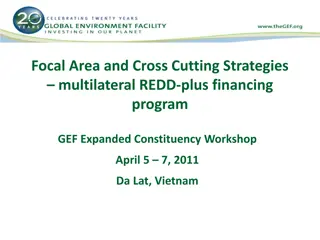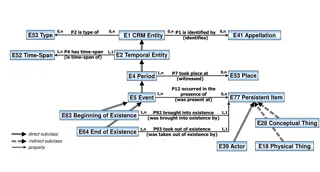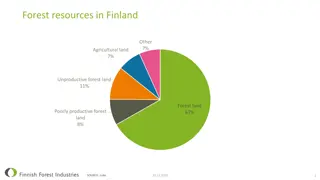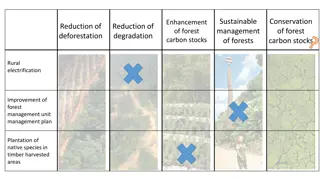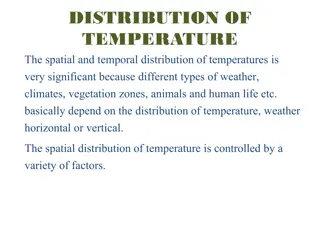Global Spatial Distribution and Economic Significance of Forest Resources
Forest resources play a crucial role in the global economy, with uneven distribution across continents. The largest forest areas are found in countries like Russia, Brazil, and Canada. Tropical forests dominate in ecological type, followed by boreal, temperate, and subtropical regions. The economic importance of forests lies in timber production, biodiversity support, carbon sequestration, and recreation opportunities.
Download Presentation

Please find below an Image/Link to download the presentation.
The content on the website is provided AS IS for your information and personal use only. It may not be sold, licensed, or shared on other websites without obtaining consent from the author. Download presentation by click this link. If you encounter any issues during the download, it is possible that the publisher has removed the file from their server.
E N D
Presentation Transcript
QUESTION 9 With examples, elaborate the spatial distribution resources and comment on its economic importance of forest
The Planning of the Question Introduction: Definition of basic concepts Main body: Spatial distribution of forest Economic importance of forest resources Conclusion: References
Introduction According to Oxford Advanced learner Dictionary 8th edition Forest is a larger area of the land that is thickly covered with trees Forest, refers to the collection of trees in an area which can be either natural or artificial Forest resources, is the renewable natural resources which found in different parts of the world
Global distribution of forest According to the Food Agriculture Organization (FAO) Global forest resources assessment (2000) report, forest cover almost 1/3 of the world land or 3869 million hectors This implies 95% is natural forest 5% is planted forest Forest are distributed unevenly across the globe Two third of the world forest is currently distributed among 10 countries: Russian Federation, Brazil, Canada, USA, China, Australia, Democratic Republic of Congo, Indonesia & Peru
Global distribution of forest: cont Forest can be grouped by their ecological type, tropical forest constitute, the major forest followed by boreal, temperate and subtropical forest respectively Region Tropics Boreal zone Temperate 11% Subtropics 9% World total Percentage 45% 35% 100%
Global distribution of forest: cont Forest are distributed unevenly across the continent: 17% in Africa 14% in Asia 27% in Europe 14% in North & Central America 23% in South America and 5% Oceania
Global distribution of forest: cont unevenly distribution depends on the nature of the area which means Climate Land (fertility or infertility) cultural aspect over the geographical area
Global distribution of forest: cont The following are the types of forest and their distribution (Rergman E, F) Tropical rain forest Subtropical evergreen forest Mediterranean forest and scrubs Temperate forest Midlatitude deciduous forest
Global distribution of forest: cont Tropical rain forest: found around the equatorial zone Characterized by: Variety of plant species Tree type are Broad leaved, Evergreen tree are dominant Examples: Mahogany, ebony, Sapele, Samba, Iroko & Okoume,
Global distribution of forest: cont Subtropical evergreen forest; Found in regions of moist subtropical climate Winters are mild Plenty of rainfall through the year.
Global distribution of forest: cont Mediterranean forest and scrubs; Are short growing season with dry summer and mild rain winters Found south of the temperate region around the coast of Mediterranean, California, Chile and Western Australia Tree found are evergreen mixed with hardwood and soft wood.
Global distribution of forest: cont Temperate forest; Season with a distinct winters & sufficient rainfall Found Eastern North America, north East Asia, western & Eastern Europe, Australia & Newzealand Tree found are deciduous & coniferous
Global distribution of forest: cont Mid latitude deciduous forest; Found in eastern North America and Western Europe Dominated by tall broad leaf trees that provide continuous and dense canopy in summer.
Global distribution of forest: cont Distribution of forest according to White Richard (1998) Temperate latitude forest Coniferous forest Tropical rainforest Cold climate (Boreal forest)
Global distribution of forest: cont Temperate latitude forest, Found in 400 and 600 north and south of equator. characterized by; Broad-leaved deciduous trees, In the autumn the leaves die and fall to the ground leaving the trees bare, in winters the trees are dormant and cease to grow and in spring new leaves appear
Global distribution of forest: cont Coniferous forest; Found in cold climate 600 North in Eurasian and North America as well as high altitude Coniferous trees are evergreens They have needle shaped leaves which reduce transpiration. Their fruits are in the form of tough cones.
Global distribution of forest: cont Tropical rainforest; Found 00 -50 North & South of equator locate in the tropics within the equatorial belt Example Amazon, Congo basin, coastal land of Ecuador, West Africa & South East Asia.
Global distribution of forest: cont Cold climate (Boreal forest) is also called the taiga Found in North America This vegetation made up of spruce, fir, pine and larce.
DISTRIBUTION 0F FOREST IN SOUTH AMERICA
DISTRIBUTION 0F FOREST IN NORTH AMERICA
Economic importance of forest For industrial use, forests provide many raw materials for the industries such as wood pulp which are used in the production of paper. By printing on paper we can produce newspapers, magazines and books which help us with an essential means of communication as well as in education system as learning and teaching materials.
Economic importance of forest; cont Provide building material, through lumbering such as timber, poles and logs which are the keys forest material which are essential for building houses and settlement, timber items is made up of wood and touch our lives in more ways than we can imagine.
Economic importance of forest; cont Sources of fuels energy, such as firewood and charcoal which come from trees. Which provide energy, which are very essential to people countries, especially in Africa, some parts of Asia and Latin America. About 90% of fuels and charcoal in from Africa, Asia and Latin America. So it provides money after selling it mostly developing
Economic importance of forest; cont Source of employment, about 10 million people are employed in forestry or in forest conservation and management activities mainly in Asia & Africa. This increase the living standard of the people
Economic importance of forest; cont Increase of national income; due to export of timber or forest product to different countries around the globe hence the country increase its source of income which enable to run the activities and economic development project smoothly.
Economic importance of forest; cont Development of tourism sector; forest used as recreational agents because different types of species and wild animal are found within it. This species act as attraction to tourist to visit and view it. Example selou game reserve and Amazon forest
Economic importance of forest; cont Development of transport system and communication network; the region or area where the forest found there must be improvement of transport network such as roads and railways to enable transportation of forest raw materials to the industries and tourist to visit tourism centre.
Conclusion Although forest has economic significance to man and different kind of living organisms forest remain to be one of the resources which faces many problem like huge deforestation for building settlement, construction of transport system and agriculture also burning of trees which led to disappearance of some valuable tree species
REFERENCES: Bergama, F.E (2005). Introduction to geography, people, places and Environment. Gabler, E.R .(2004).Essential of physical Geography. Thomson learning. 7th edition. Richard W. (1998). Africa in focus. Waugh D. (2004). Geography an Integrated Approach. USA, 3rd edition.







